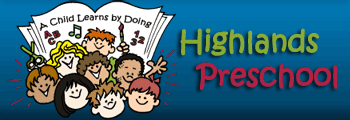A Child Learns by Doing
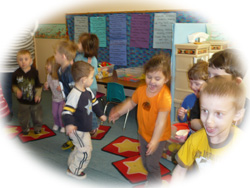 Our philosophy of early childhood education focuses on learning though play and hands-on experiences. This allows for the development of the "whole" child-intellectually, socially, emotionally, and physically-and unlocks your child's full potential while they experience a growing sense of self-worth, independence, and the beginning of a lifetime of love for learning.
Our philosophy of early childhood education focuses on learning though play and hands-on experiences. This allows for the development of the "whole" child-intellectually, socially, emotionally, and physically-and unlocks your child's full potential while they experience a growing sense of self-worth, independence, and the beginning of a lifetime of love for learning.
Preschool is a time to develop trust and respect for others, as well as the world around us. Young children learn by involving themselves in exploring, discovering, modeling and continually adapting to these real-life experiences. Using hands-on art, science experiments, group activities, outdoor play, songs, circle time games, story time and more, we make school as fun as it is educational.
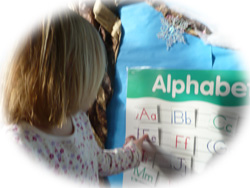 We provide a safe and joyful learning environment for all children. We embrace diversity, as children learn so much from their peers. Young learners bring their own cultures, experiences, languages, and personalities with them. They discover through these friendships that we are all more similar than different, and what makes us different also makes us special. Empathy, compassion, and as we say here at preschool, "being a good friend" are the keys to successful relationships. Most important of all, these young children are learning to see themselves as individuals who are each unique and special with qualities unlike any other.
We provide a safe and joyful learning environment for all children. We embrace diversity, as children learn so much from their peers. Young learners bring their own cultures, experiences, languages, and personalities with them. They discover through these friendships that we are all more similar than different, and what makes us different also makes us special. Empathy, compassion, and as we say here at preschool, "being a good friend" are the keys to successful relationships. Most important of all, these young children are learning to see themselves as individuals who are each unique and special with qualities unlike any other.
Example Daily Schedule
Schedules vary by teacher/class.
| AM Classes | PM Classes | Activity |
| 9-10 am | 12-1 pm | Welcome to class and art project, seat work |
| 10-10:15 am | 1-1:15 pm | Snack time |
| 10:15-10:45 am | 1:15-1:45 pm | Big Room time |
| 10:45-11 am | 1:45-2 pm | Circle time |
| 11-11:30 am | 2-2:30 pm | Playground time |
| 11:30-11:45 am | 2:30-2:45 pm | Story time |
| 11:45 am | 2:45 pm | Dismiss |
Fun Things We Do
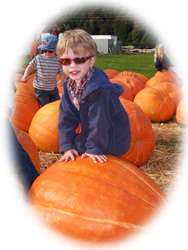
Field Trips
We take exciting field trips each year to destinations such as the Pumpkin Patch/Farm and StoryBook Theater.
Parties
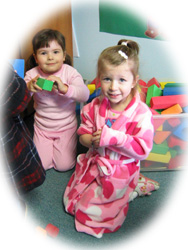
We have a number of special celebrations throughout the school year during normal classroom hours, including a Halloween Party, Winter Holiday Party, Valentines Party, and Spring Fling Party.
Spirit Days
The kids have a wonderful time dressing up on Spirit Days such as "Pajama Day," "Crazy Hair & Hat Day," or "Pirates and Princesses Day!"
Special Events
Each year, some very special educational and entertaining guests visit us at Highlands Preschool. These may include a storytime visit from the local librarian or a great show from a performer such as Xakary the Magician!
"Preschool" Grade Level Curriculum (Threes/Early Threes)
Language, Speaking, Listening and Play
- Use language to communicate wants and needs
- Answer yes/no questions verbally
- Use complete sentences
- Comprehend language in most age-appropriate stories, and in age-appropriate conversations
- Retell simple stories
- Engage in basic conversations with turn-taking
- Begin to use language to explain, persuade, describe process and tell stories
- Show rapid increase in the acquisition of new words that describe actions, emotions, things or ideas
- Engage in socio-dramatic play communicating story line, characters, events, and outcomes (i.e., "We are a family," "I am the mommy," "The baby is hungry and I need to feed her," etc.)
- Begin to negotiate turn taking
- Engage in singing, rhymes, chants and finger plays
- Learn though play (e.g., "Let's build a tower," "The bigger blocks go on the bottom."
Comprehension and Cognition
- Make connections between and among books, experiences and facts
- Engage in some group activities that illustrate/demonstrate narrative, explanatory, and procedural process (e.g., making a recipe, watching a butterfly emerge from a cocoon, etc.)
- Comprehend and respond to books and other texts
- Articulate and understand the meaning of basic text (i.e., "What is this book about?")
- Focus attention on tasks with adult support
- Answer personal questions about a text (i.e., "What was your favorite part?")
- Engage in inquiry and investigations, analyzing outcomes and drawing conclusions
- Hold small amounts of information in mind to complete tasks or follow multi-step directions
Reading (Decoding) and Writing (Encoding)
- Recognize first name in print
- Use classification skills
- Demonstrate knowledge of patterns
- Listen to narrative, explanatory, procedural, and mixed genre texts read aloud
- Distinguish print from pictures
- Turn pages of a book
- Draw pictures and dictates to compose a narrative
- Write to convey meaning (may be marks, scribbles or letters)
- Request favorite books to be re-read
- Begin to recognize first name in print
Social and Emotional Development
- Occupy self, initiate own play activities, or initiate own play on simple suggestion
- Transition easily from one activity to another
- Listen attentively to teacher during group time
- Play and share cooperatively with other children
- Follow one- and two-step directions
- Respect and show concern for people and things
- Separate from important adults, sometimes relying on another adult to feel safe
- Know self as part of the family, culture, and/or community to which the family belongs
- Enjoy creating own play activities
- Release tensions though laughter, tears, trembling, and/or talking, becoming more relaxed and cooperative afterwards
- Make plans for a way to do something (may or may not follow though)
- Identify simple safety rules and expect others to follow them as well
- Predict what comes next in a day when there is a consistent schedule
- Respond to directions from adults about putting things away, noticing where they belong and being careful with them
- Wait for a turn
- Draw on their own past experiences to choose current actions
- Identify questions and puzzles and have ideas about ways to figure them out
- Think of a different way of doing something when confronting a problem, with adult help
- Express delight in own abilities ("I did it myself!")
- Be able to identify when something is hard to do
- Enjoy the challenge of trying new skills
- Dress and undress (take off coat and put it where it belongs/put coat on)
- Begin to take care of own toileting needs and wash hands, with help when needed
- Recognize when making a mistake and sometimes adjust behaviors to correct it
- Tell stories and give other children a chance to tell theirs
- Take on various rolls in play, identify how each person should act, act out the part for a brief time, and enjoying changing roles
- Play make-believe with toy animals, dolls and people
- Show affection or closeness with peers and important adults
- React to peers' feelings with empathy
- Participate in conversations, take turns in group conversations, and listen to others in a group for a short period of time
- Accept and reach out to children that are different
- Communicate needs, ideas, actions, and feelings with gestures, body language, facial expression, tone of voice, and words
Counting and Cardinality
- Count verbally to 10 or beyond
- Understand cardinality in counting, for at least five objects
- Count out five objects
- Instantly recognize and name the number of items in a set of three or four
- Make a small collection with the same number as another collection
- Use gestures or words to make comparisons
- Compare groups of 1-5 by matching or counting when objects in each group are about the same size
Operations and Algebraic Thinking
- Know that a whole is bigger than its parts
- Find the total sum of small groups of items
- Combine and separate up to five objects and describe the parts, identifying which part has more, less, or the same
- Begin to understand that when adding two numbers, it does not matter which number "comes first"
- Begin to learn and repeat basic AB patterns
Measurement and Data
- Compare size by sight and to hands, feet, etc.
- Compare and order a small set of objects as appropriate according to size, length, weight, area, volume
- Know usual sequence of basic daily events
- Know a few ordinal numbers
- Fill simple pattern block puzzles using trial and error
- Sort and/or describe objects by a non-geometric attribute (size, color) or by shape
Geometry
- Start to recognize more shapes in real world
- Follow simple directions related to proximity (behind, under, beside, next to, between)
- Recognize some shapes with different sizes and orientation
- Match familiar shapes (circle, triangle, square, rectangle, heart and star) with the same size and orientation
Fine Motor Skills
- String beads
- Use various art tools: brushes, sponges, rollers, crayons, markers, oil pastels, etc.
- Use stickers
- Sort small objects
- Build with blocks and other manipulatives
Large Motor Skills
- Utilize large indoor and outdoor spaces with access to stairs, slides, climbing structures, trikes, ride-in cars, and spaces to run and jump
Science (units vary and alternate by year)
- Weather
- ZooAnimals
- Farm Animals
- Amphibians and Reptiles
- Seasons
- Space
- Sea Life
- Dinosaurs
- Polar Animals
- Woodland Animals
- Five senses
- Bugs and Insects
- Color
- Water and Ice
- Plants and Flowers
- How Vegetables and Pumpkins Grow
"Pre-K" Grade Level Curriculum (Fours/Fives)
Language, Speaking, Listening
- Speak and be understood by adults and peers
- Speak using complete sentences
- Express and understand thoughts, ideas, and needs, and increasingly use language to explain, persuade, describe process, and tell stories
- Demonstrate a greater understanding of words and vocabulary
- Engage in more elaborate and creative play and imagination
- Participate in developmentally appropriate conversations
- Engage in group word games and calendar time
- Understand that letters make sounds and know some of them
Comprehension and Cognition
- Ask and answer simple questions about stories, games, or activities while engaged in them
- Determine meaning from images and pictures
- Begin to identify basic story elements (who are some characters?)
- Make relevant predictions about experiments, experiences, and texts (e.g., science experiments like, "Will it sink or float?," or questions about a story like, "What do you think will happen next?")
- Make increasingly detailed observations and descriptions of objects
- Increase attention, focus, and independence when engaged in tasks and experiences
- Hold an increasing amount of information in mind to complete tasks and follow multi-step directions>
Reading (Decoding) and Writing (Encoding)
- Write name and recognize it in print (may be messy letter shapes)
- Practice writing letters using a variety of tools (i.e., crayons, markers, fingers in the sand, Playdough, and pencils)
- Hear and identify rhymes
- Know print has meaning
- Know what direction the print is read
- Identify some letters
- Write to convey meaning (using some letters)
- Distinguish between letters and numbers
- Demonstrate an understanding of the connection between print and speech
- Use letter sound knowledge for reading small simple words
- Engage in singing rhymes, chants, and finger plays to hear and identify syllables
- Draw pictures, write, and/or dictate to compose a narrative
- Learn simple sight words by rote memorization
- Write to convey meaning (using some letters)
Social and Emotional Development
- Communicate effectively with peers
- Answer open ended questions
- Engage in cooperative play with peers
- Display appropriate behaviors during play
- Make decisions and solve problems with other children appropriately, sometimes with adult help
- Sustain play for an appropriate amount of time
- Control own emotions
- Accept unexpected changes
- Be attentive and participate during circle time
- Remain seated and focused during seat work
- Understand and follow important safety rules
- Seek emotional support from caregivers
- Listen to what other children want, and take those desires into account
- Make and follow plans for games with other children
- Ask for help from another child or adult to solve a problem
- Ask adults questions to gain information
- Be able to explain what they have done and why, including any changes made to their plans
- Anticipate consequences of own behavior
- With help, consider possibilities and plan effective approaches to individual problems
- Adjust behaviors to settings (such as using an outdoor or indoor voice), sometimes with reminders
- Be cooperative and not hurtful to others
- Seek to understand cause and effect ("If I do this, why does this happen?")
- Be able to talk about ways to solve a problem that helps another child
- Recognize when making a mistake and fix these errors during a task
- Enjoy challenging themselves to try new and increasingly difficult activities
- Spend time practicing skills that are difficult, be aware of what they find difficult, and try to do it better
- Dress and undress (take off coat and put it where it belongs/put coat on)
- Begin to take care of own toileting needs and wash hands, with help when needed
- Take pride in their own family composition and have an interest in others, understanding that families are diverse
- Recognize and respect similarities between self and other people, such as gender, race, special needs, cultures, languages, communities and family structures
- Observe that others may have ideas or feelings that differ from their own
- Care about other children when they are hurt or upset
- Associate emotions with words and facial expressions, and use words to describe those emotions
- Invite other children to join groups or other activities
- State own point of view and likes and dislikes using words, gestures, and/or pictures
- Understand the ideas of "same" and "different" and ask questions about these in others (such as clothing, language, hair style)
- Recognize the importance of cultural celebrations and traditions
- Use dramatic play activities to act out familiar activities, stories, or events
- Take pride in showing others their own creations ("Look at my picture.")
- Express self and feelings though art, music, movement, and dance
- Cooperate with other children, share, and take turns
- Listen to, and respond in, a group discussion for a short period of time
- Accept and reach out to children who are different
Counting and Cardinality
- Count verbally to 20 and beyond
- Count 10-20 objects accurately
- Give next number in sequence (1-10)
- Identify numerals 1-10
- Write some numerals and connect each to counted objects
- Instantly recognize and name the number of items in a set of five
- Make a collection with the same number as another collection
- Use comparative language (more, less, same) to compare collections up to 10 by counting, even when the collection are made up of objects of various sizes
Operations and Algebraic Thinking
- Find results for joining and take-away by using concrete objects and counting all
- Have intuitive understanding that when adding three numbers, it does not matter which two you add first
- Use "counting-on" and "counting-up-to" strategies to find results
- Begin to add and subtracts within 5
- Represent addition and subtraction within 10 with objects
- Make sets of 6–10 objects and describe the parts, identifying which part has more, less, or the same
- Make algebraic generalizations with guidance (such as subtracting zero from any number gives that number, or subtracting a number from itself gives zero)
- Create and repeat patterns with more complexity, building on and expanding the basic AB pattern
Measurement and Data
- Physically align two objects to determine which is longer or if same length
- Understand that a ruler is used for measuring (may be able to measure, but often lacks understanding or skill)
- Describe measurable attributes of objects
- Directly compare two objects
- Begin to use ordinal numbers from first to tenth
- Put several shapes together to make one part of a picture
- Sort objects by one attribute
- Begin to sort and classify objects into more than one category and count the number in each
Geometry
- Recognize and compare most familiar shapes (circle, triangle, square, rectangle, heart, star, rhombus, hexagon, and octagon) and typical examples of other shapes, such as cubes and sphere
- Compose simple shapes to form larger shapes
- Name at least some three-dimensional shapes
- Recognize sides and angles as distinct geometric objects
- Identify positions of objects in space by using words like, beside, inside, next to, above, below, under
- Use and respond to positional words
- Recognize shapes in the environment
- Begin to name shapes regardless of orientation
Fine Motor Skills
- Hold a pencil correctly
- Trace pre-writing lines with control
- Hold scissors correctly
- String beads
- Use various art tools: brushes, sponges, rollers, crayons, markers, oil pastels, etc.
- Use stickers
- Sort small objects
- Work on puzzles
- Use glue
- Build with blocks and other manipulatives
Large Motor Skills
- Large indoor and outdoor spaces with access to stairs, slides, climbing structures, trikes, ride in cars, spaces to run and jump
Science (units vary and alternate by year)
- Weather
- Zoo Animals
- Farm Animals
- Amphibians and Reptiles
- Seasons
- Space
- Sea Life
- Dinosaurs
- Polar Animals
- Woodland Animals
- Five senses
- Bugs and Insects
- Color
- Water and Ice
- Plants and Flowers
- How Vegetables and Pumpkins Grow
